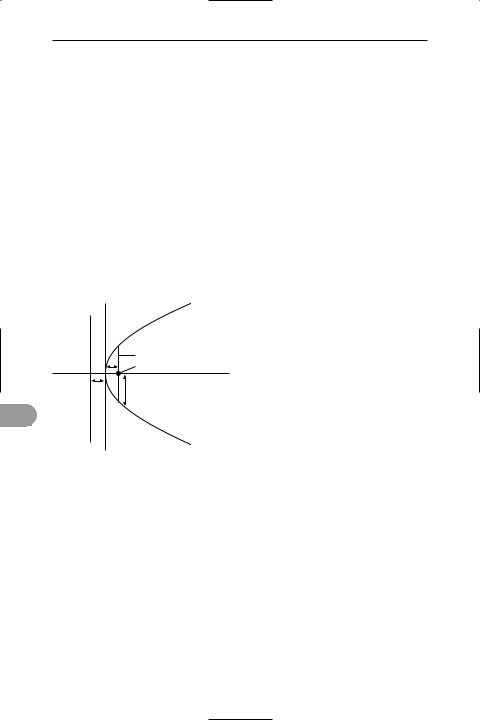
A Dictionary of Science
.pdf
palaeoclimatology |
596 |
tion of many reptiles the mammals became abundant on land. By the end of the epoch primates and rodents had evolved.
palaeoclimatology The study of climates of earlier geological periods. This is based largely on the study of sediments that were laid down during these periods and of fossils. The changes in the positions of the continents as a result of *continental drift and *plate tectonics complicate the study.
palaeoecology The study of the relationships of *fossil organisms to each other and to their environments. It involves the study both of the fossils and of the surrounding rocks in which they are found. Trace fossils may provide information on the behaviour of the organism.
Palaeolithic The Old Stone Age, lasting in Europe from about 2.5 million to 9000 years ago, during which humans used primitive stone tools made by chipping stones and Ûints.
palaeomagnetism The study of magnetism in rocks, which provides information on variations in the direction and intensity of the earth’s magnetic Üeld with time. During the formation of an igneous or sedimentary rock containing magnetic minerals the polarity of the
pearth’s magnetic Üeld at that time becomes ‘frozen’ into the rock. Studies of this fossil magnetism in samples of rocks have enabled the former positions of magnetic poles at various geological times to
be located. It has also revealed that periodic reversals in the geomagnetic Üeld have taken place (i.e. the N-pole becomes the S-pole and vice versa). This information has been important in plate tectonics in establishing the movements of lithospheric plates over the earth’s surface.
The magnetic reversals provided crucial evidence for the sea-Ûoor spreading hypothesis proposed in the early 1960s.
palaeontology The study of extinct organisms, including their structure, environment, evolution, and distribution, as revealed by their *fossil remains. Palaeontological work also makes important contributions to geology in revealing stratigraphic relationships between rock strata and determining the physical ap-
pearance and climate of the earth during past geological ages. See also palaeobotany; palaeoecology; palaeozoology.
Palaeozoic The Ürst era of *Phanerozoic time. It follows the *Precambrian and is subdivided into the Lower Palaeozoic, comprising the *Cambrian, *Ordovician, and *Silurian periods, and the Upper Palaeozoic, comprising the *Devonian, *Carboniferous, and *Permian periods. It extended from about 590 million years ago to about 248 million years ago, when it was succeeded by the *Mesozoic era.
palaeozoology The branch of *palaeontology concerned with the study of animals throughout geological time, as revealed by their *fossil remains.
palate The roof of the mouth cavity of vertebrates, which separates the *buccal and nasal cavities. In mammals it is divided into two zones, the bony hard palate and the soft palate, and completely separates the buccal cavity from the air passage to enable simultaneous eating and breathing.
palisade mesophyll See mesophyll.
palladium Symbol Pd. A soft white ductile *transition element (see also platinum metals); a.n. 46; r.a.m. 106.4; r.d. 12.02; m.p. 1552°C; b.p. 3140±1°C. It occurs in some copper and nickel ores and is used in jewellery and as a catalyst for hydrogenation reactions. Chemically, it does not react with oxygen at normal temperatures. It dissolves slowly in hydrochloric acid. Palladium is capable of occluding 900 times its own volume of hydrogen. It forms few simple salts, most compounds being complexes of palladium(II) with some palladium(IV). It was discovered by William Woolaston (1766–1828) in 1803.
pallium See cerebral cortex.
palmitate (hexadecanoate) A salt or ester of palmitic acid.
palmitic acid (hexadecanoic acid) A 16carbon saturated fatty acid, CH3(CH2)14- COOH; r.d. 0.85; m.p. 63°C; b.p. 390°C. Glycerides of palmitic acid occur widely in plant and animal oils and fats.
palp An elongated sensory organ, usually near the mouth, in many inverte-

597 |
para- |
brates. Examples are the tactile head appendages of polychaete worms, the ciliated Ûap of tissue that produces feeding currents in bivalve molluscs, the distal part of the *mandibles of crustaceans, and the olfactory parts of the Ürst and second *maxillae of some insects.
palynology (micropalaeontology) The study of fossil pollen and spores (pollen analysis) and various other *microfossils, such as coccoliths and dinoÛagellates. Palynology is used in stratigraphy, palaeoclimatology, and archaeology. Pollen and spores are very resistant to decay and therefore their fossils are found in sedimentary rocks. They may be extracted by various methods, including boiling with potassium hydroxide solution, washing with strong oxidizing mixtures, and centrifuging repeatedly. Spores and pollen are classiÜed according to shape, form of aperture, and both internal and external details of the exine (outer coat). They indicate the nature of the dominant Ûora, and therefore the climate and conditions of the period in which they lived.
pancreas A gland in vertebrates lying between the duodenum and the spleen. Under the inÛuence of the hormone *secretin it secretes pancreatic juice containing digestive enzymes or their precursors (mainly *trypsin, *chymotrypsin, *amylase, and *lipase) into the duodenum via the pancreatic duct. It also contains groups of cells – the *islets of Langerhans
– that function as an *endocrine gland, producing the hormones *insulin and *glucagon, which regulate blood sugar levels.
pancreozymin See cholecystokinin.
panicle A type of Ûowering shoot common in the grass family. The primary axis bears groups of *racemes and is itself racemose, as the youngest groups of Ûowers are at the top (e.g. oat). The term may be used loosely for any form of branched *racemose inÛorescence; for example, the horse chestnut is a raceme of cymes. Both these arrangements are seen in the family Polygonaceae (docks and sorrels).
pantothenic acid A vitamin of the
*vitamin B complex. It is a constituent of *coenzyme A, which performs a crucial
role in the oxidation of fats, carbohydrates, and certain amino acids. DeÜciency rarely occurs because the vitamin occurs in many foods, especially cereal grains, peas, egg yolk, liver, and yeast.
papain A protein-digesting enzyme (see protease) occurring in the fruit of the West Indian papaya tree (Carica papaya). It is used as a digestant and in the manufacture of meat tenderizers.
paper chromatography A technique for analysing mixtures by *chromatography, in which the stationary phase is absorbent paper. A spot of the mixture to be investigated is placed near one edge of the paper and the sheet is suspended vertically in a solvent, which rises through the paper by capillary action carrying the components with it. The components move at different rates, partly because they absorb to different extents on the cellulose and partly because of partition between the solvent and the moisture in the paper. The paper is removed and dried, and the different components form a line of spots along the paper. Colourless substances are detected by using ultraviolet radiation or by spraying with a substance that reacts to give a coloured spot (e.g. ninhydrin gives a blue coloration with amino acids). The components can
be identiÜed by the distance they move in p a given time.
papilla Any cone-shaped protuberance projecting from the surface of an organ or organism. Papillae occur, for example, on the tongue, in the kidneys, and, in plants, on the surface of many petals.
papovavirus One of a group of DNAcontaining viruses that produce tumours in their hosts. Papillomaviruses produce nonmalignant tumours (such as warts) in all vertebrates; polyomaviruses produce malignant tumours in certain classes of vertebrates (not including humans).
pappus A group of modiÜed *sepals, often in the form of a ring of silky hairs. For example, when the fruit of the dandelion matures a pappus of hairs persists at the top of a thin stalk forming a parachute-like structure, which serves to disperse the fruit.
para- 1. PreÜx designating a benzene

parabola |
598 |
compound in which two substituents are in the 1,4 positions, i.e. directly opposite each other, on the benzene ring. The abbreviation p- is used; for example, p- xylene is 1,4-dimethylbenzene. Compare ortho-; meta-. 2. PreÜx denoting the form of diatomic molecules in which the nuclei have opposite spins, e.g. parahydrogen. Compare ortho-.
parabola A *conic with eccentricity e = 1. It is the locus of a point that moves so that its distance from the focus is equal to its perpendicular distance from the directrix. A chord through the focus, perpendicular to the axis, is called the latus rectum. For a parabola with its vertex at the origin, lying symmetrically about the x-axis, the equation is y2 = 4ax, where a is the distance from the vertex to the focus. The directrix is the line x = –a, and the latus rectum is 4a. See illustration.
|
y |
|
|
|
|
|
a |
latus rectum |
|
|
|
focus |
|
|
|
|
|
|
|
|
a |
|
|
x |
|
|
2a |
|
|
|
|
|
|
|
p |
|
|
|
|
directrix |
|
|
y2 |
= 4ax |
|
|
|
|
A parabola
parabolic reÛector (paraboloidal reÛector) A reÛector having a section that is a parabola. A concave parabolic reÛector will reÛect a parallel beam of radiation through its focus and, conversely, will produce a parallel beam if the source of the radiation is placed at its focus. Parabolic mirrors are used in reÛecting optical *telescopes to collect the light and in some light sources that require a parallel beam of light. In radio telescopes a dish aerial may also consist of a parabolic reÛector.
paraboloid A solid formed by rotating a parabola about its axis of symmetry.
parafÜn See petroleum.
parafÜns See alkanes. parafÜn wax See petroleum.
paraformaldehyde See methanal.
parahydrogen See hydrogen.
paraldehyde See ethanal.
parallax 1. An apparent displacement of a distant object (with respect to a more distant background) when viewed from two different positions. If such an object is viewed from two points at either end of a base line, the angle between the lines joining the object to the ends of the base line is the angle of parallax. If the base line is the distance between the two eyes of an observer the angle is called the binocular parallax. 2. The angular displacement in the apparent position of a celestial body when observed from two different points. Diurnal parallax results from the earth’s daily rotation, the celestial body being viewed from the surface of the earth rather than from its centre. Annual parallax is caused by the earth’s motion round the sun, the celestial body being viewed from the earth rather than from the centre of the sun. Secular parallax is caused by the motion of the solar system relative to the Üxed stars.
parallel circuits A circuit in which the circuit elements are connected so that the current divides between them. For resistors in parallel, the total resistance, R, is given by 1/R = 1/r1 + 1/r2 + 1/r3 …, where r1, r2, and r3 are the resistances of the individual elements. For capacitors in parallel, the total capacitance, C, is given by C = c1 + c2 + c3 ….
parallelepiped (parallelopiped) A solid with six faces, all of which are parallelograms.
parallel evolution The development of related organisms along similar evolutionary paths due to strong selection pressures acting on all of them in the same way. It is debatable if the phenomenon really exists: many argue that all evolution is ultimately *convergent or divergent (see adaptive radiation).
parallelogram of forces See parallelogram of vectors.
parallelogram of vectors A method

599 |
parasympathetic nervous system |
A |
A |
|
R |
river |
B |
|
|
boat |
B |
A is the velocity of the boat with respect to the water; B is the velocity of the water with respect to the bank
Parallelogram of velocities
of determining the *resultant of two *vector quantities. The two vector quantities are represented by two adjacent sides of a parallelogram and the resultant is then the diagonal through their point of intersection. The magnitude and direction of the resultant is found by scale drawing or by trigonometry. The method is used for such vectors as forces (parallelogram of forces) and velocities (parallelogram of velocities). See illustration.
parallelogram of velocities See par-
allelogram of vectors.
parallel processing A technique that allows more than one process – stream of activity – to be running at any given moment in a computer system, hence processes can be executed in parallel. This means that two or more processors are active among a group of processes at any instant.
parallel spins Neighbouring spinning electrons in which the *spins, and hence the magnetic moments, of the electrons are aligned in the same direction. The interaction between the magnetic moments of electrons in atoms is dominated by exchange interactions (see exchange force). Under some circumstances the exchange interactions between magnetic moments favour parallel spins, while under other conditions they favour *antiparallel spins. The case of ferromagnetism (see magnetism) is an example of a system with parallel spins.
paramagnetism See magnetism.
parametric equation An equation of a curve expressed in the form of the parameters that locate points on the curve. The parametric equations of a straight line are
R is the resultant velocity of the boat with respect to the bank
x = a + bt, y = c + dt. For a circle, they are x = acosθ, y = asinθ.
paraphyletic See monophyletic.
parapositronium See positronium.
parasitic capture The absorption of a neutron by a nuclide that does not result in either Üssion or a useful artiÜcial element.
parasitism An association in which one organism (the parasite) lives on (ectoparasitism) or in (endoparasitism) the body of another (the *host), from which it obtains its nutrients. Some parasites inÛict comparatively little damage on their host, but many cause characteristic diseases (these are, however, never immediately fatal, as killing the host would destroy the parasite’s source of food). Parasites are usually
highly specialized for their way of life, p which may involve one host or several (if
the *life cycle requires it). They typically produce vast numbers of eggs, very few of which survive to Ünd their way to another suitable host. Obligate parasites can only survive and reproduce as parasites; facultative parasites can also live as *saprotrophs. The parasites of humans include Ûeas and lice (which are ectoparasites), various bacteria, protozoans, and fungi (endoparasites causing characteristic diseases), and tapeworms (e.g. Taenia solium, which lives in the gut).
parasympathetic nervous system
Part of the *autonomic nervous system. Its nerve endings release acetylcholine as a *neurotransmitter and its actions tend to antagonize those of the *sympathetic nervous system. For example, the parasympathetic nervous system increases salivary gland secretion, decreases heart rate, promotes digestion (by increasing

parathyroid glands |
600 |
*peristalsis), and dilates blood vessels, while the sympathetic nervous system has opposite effects.
parathyroid glands Two pairs of *endocrine glands situated behind, or embedded within, the thyroid gland in higher vertebrates. They produce *parathyroid hormone, which controls the amount of calcium in the blood. See also c cell.
parathyroid hormone (PTH; parathormone; parathyrin) A peptide hormone secreted by the *parathyroid gland in response to low levels of calcium in the blood. It acts to maintain normal blood levels of calcium by (1) increasing the number of osteoclasts, cells that break down the bone matrix and release calcium into the blood; (2) increasing the reabsorption of calcium and magnesium ions in the kidney tubules, so that their concentration is maintained in the blood;
(3) converting *vitamin D to its active form, which increases calcium absorption in the intestine. Parathyroid hormone acts in opposition to *calcitonin.
p
paraxial ray A ray of light that falls on a reÛecting or refracting surface close to and almost parallel to the axis. It is for such rays that simple lens theory can be developed, by means of making small angle approximations.
parenchyma 1. A plant tissue consisting of roughly spherical relatively undifferentiated cells, frequently with air spaces between them. The cortex and pith are composed of parenchyma cells (see ground tissues). 2. Loose *connective tissue formed of large cells. Its function is to pack the spaces between organs in some simple acoelomate animals, such as Ûatworms (Platyhelminthes).
parent 1. (in biology) a. Either male or female partner that together produce offspring in the process of sexual reproduction. See also p. b. Denoting an organism or cell that gives rise to new organisms or cells, as by asexual reproduction or cell division. 2. (in physics) See daughter.
parity Symbol P. The property of a *wave function that determines its behaviour when all its spatial coordinates are reversed in direction, i.e. when x,y,z are replaced by –x,–y,–z. If a wave function
ψ satisÜes the equation ψ(x,y,z) = ψ(–x,–y,–z) it is said to have even parity, if it satisÜes ψ(x,y,z) = –ψ(–x,–y,–z) it has odd parity. In general,
ψ(x,y,z) = Pψ(–x,–y,–z),
where P is a quantum number called parity that can have the value +1 or –1. The principle of conservation of parity (or space-reÛection symmetry) would hold if all physical laws could be stated in a coordinate system independent of leftor right-handedness. If parity was conserved there would therefore be no fundamental way of distinguishing between left and right. In electromagnetic and strong interactions, parity is, in fact, conserved. In 1956, however, it was shown that parity is not conserved in weak interactions. In the beta decay of cobalt–60, for example, the electrons from the decay are emitted preferentially in a direction opposite to that of the cobalt spin. This experiment provides a fundamental distinction between left and right.
parsec A unit of length used to express astronomical distance. The distance at which the mean radius of the earth’s orbit subtends an angle of one second of arc. One parsec is equal to 3.0857 × 1016 metres or 3.2616 light years.
parthenocarpy The formation of fruit without prior fertilization of the Ûower by pollen. The resulting fruits are seedless and therefore do not contribute to the reproduction of the plant; examples are bananas and pineapples. Plant *growth substances may have a role in this phenomenon, which can be induced by auxins in the commercial production of tomatoes and other fruits.
parthenogenesis The development of an organism from an unfertilized egg. This occurs sporadically in many plants (e.g. dandelions and hawkweeds) and in a few animals, but in some species it is the main and sometimes only method of reproduction. For example, in some species of aphid, males are absent or very rare. The eggs formed by the females contain the full (diploid) number of chromosomes and are genetically identical. Variation is consequently very limited in species that reproduce parthenogenetically.

601 |
Pascal, Blaise |
partial A simple component of a complex tone. When a musical instrument produces a note, say, middle C, it will produce a complex tone in which the fundamental frequency is mixed with a number of partials. Some of these partials, for example, if the note is produced by bowing a taut string, will be *harmonics, i.e. integral multiples of the fundamental. If the string is struck, however, some of the partials can be inexact multiples of the fundamental. Partials are not therefore identical with harmonics.
partial derivative The inÜnitesimal change in a function consisting of two or more variables when one of the variable changes and the others remain constant. If z = f(x,y), ∂z/∂x is the partial derivative of z with respect to x, while y remains unchanged. A partial differential equation, such as the *Laplace equation, is an equation containing partial derivatives of a function.
partial eclipse See eclipse.
partial pressure See dalton’s law.
particle 1. (in physics) One of the fundamental components of matter. See elementary particles. 2. (in mechanics) A hypothetical body that has mass but no physical extension. As it is regarded as having no volume, a particle is incapable of rotation and therefore can only have translational motion. Thus a real body may often, for translational purposes, be regarded as a particle located at the body’s centre of mass and having a mass equal to that of the whole body.
particle physics The study of *elementary particles.
particulate inheritance The transmission from parent to offspring of separate units that determine characteristics. Gregor Mendel observed that *recessive characteristics, absent in the offspring of a cross in which only one parent possessed them, reappeared repeatedly in the progeny of subsequent crosses. This led him to formulate his theory of inherited ‘factors’ (now called *alleles) that retain their identity through succeeding generations (see mendel’s laws). Compare blending inheritance.
partition If a substance is in contact with two different phases then, in general, it will have a different afÜnity for each phase. Part of the substance will be absorbed or dissolved by one and part by the other, the relative amounts depending on the relative afÜnities. The substance is said to be partitioned between the two phases. For example, if two immiscible liquids are taken and a third compound is shaken up with them, then an equilibrium is reached in which the concentration in one solvent differs from that in the other. The ratio of the concentrations is the partition coefÜcient of the system. The partition law states that this ratio is a constant for given liquids.
partition coefÜcient See partition.
partition function The quantity Z deÜned by Z = Σ exp(–Ei/kT), where the sum is taken over all states i of the system. Ei is the energy of the ith state, k is the *Boltzmann constant, and T is the thermodynamic *temperature. Z is a quantity of fundamental importance in equilibrium *statistical mechanics. For a system in which there are non-trivial interactions, it is very difÜcult to calculate the partition function exactly. For such systems it is necessary to use *approximation techniques and/or *model systems.
The partition function links results at the p atomic level to *thermodynamics, since Z
is related to the Helmholtz *free energy F by F = kTlnZ.
parton A pointlike, almost free, particle postulated as a component of nucleons. The parton model enabled the results of very high-energy experiments on nucleons to be understood. See quantum chromodynamics.
parturition The act of giving birth to young at the end of the *gestation period. Fetal hormones cause the process to start.
pascal The *SI unit of pressure equal to one newton per square metre.
Pascal, Blaise (1623–62) French mathematician and physicist. An infant prodigy, he had already made a mechanical calculating machine by 1642. In physics he formulated *Pascal’s law concerning Ûuid pressure and the principle behind the hy-

Pascal’s law |
602 |
draulic press. The SI unit of pressure is named after him.
Pascal’s law In a conÜned Ûuid, externally applied pressure is transmitted uniformly in all directions. In a static Ûuid, force is transmitted at the speed of sound throughout the Ûuid and acts at right angles to any surface in or bounding the Ûuid. This principle is made use of in the hydraulic jack, the pneumatic tyre, and similar devices. The law was discovered in 1647 by Blaise Pascal.
Pascal’s triangle A triangular array of numbers in which each number is the sum of the two numbers immediately above it (except for the 1s):
1
1 1
1 2 1
1 3 3 1
1 4 6 4 1
1 5 10 10 5 1
1 6 15 20 15 6 1
1 7 21 35 35 21 7 1
and so on. The numbers in each row are the coefÜcients of the expansion of the binomial (x + y)n (see binomial theorem). It is named after Blaise Pascal.
Paschen–Back effect An effect in
patomic line *spectra that occurs when the atoms are placed in a strong magnetic Üeld. Spectral lines that give the anoma-
lous *Zeeman effect when the atoms are placed in a weaker magnetic Üeld have a
different splitting pattern in a very strong magnetic Üeld in which the spectral lines go back to the pattern of the normal Zeeman effect. The Paschen–Back effect is named after the German physicists Louis Paschen (1865–1947) and Ernest Back (1881–1959), who discovered it in 1912.
Paschen series See hydrogen spectrum.
passive Describing a solid that has reacted with another substance to form a protective layer, so that further reaction stops. The solid is said to have been ‘rendered passive’. For example, aluminium reacts spontaneously with oxygen in air to form a thin layer of *aluminium oxide, which prevents further oxidation. Similarly, pure iron forms a protective oxide
layer with concentrated nitric acid and is not dissolved further.
passive device 1. An electronic component, such as a capacitor or resistor, that is incapable of ampliÜcation. 2. An artiÜcial *satellite that reÛects an incoming signal without ampliÜcation. 3. A solarpower device that makes use of an existing structure to collect and utilize solar energy without the use of pumps, fans, etc. 4. A radar device that provides information for navigation, guidance, surveillance, etc., by receiving the microwave radiation. Such a passive device emits no microwave energy itself and therefore does not disclose its position. 5. A system that detects an object by the radiation that it emits, rather than by reÛecting radiation off it, as in a passive infrared detector (PIT detector). Compare active
device.
passive immunity See immunity.
passive transport See diffusion.
Pasteur, Louis (1822–95) French chemist and microbiologist, who held appointments in Strasbourg (1849–54) and Lille (1854–57), before returning to Paris to the Ecole Normale and the Sorbonne. From 1888 to his death he was director of the Pasteur Institute. In 1848 he discovered *optical activity, in 1860 relating it to molecular structure. In 1856 he began work on *fermentation, and by 1862 was able to disprove the existence of *spontaneous generation. He introduced *pasteurization (originally for wine) in 1863. He went on to study disease and developed vaccines against cholera (1880), anthrax (1882), and rabies (1885).
pasteurization The treatment of milk to destroy disease-causing bacteria, such as those of tuberculosis, typhoid, and brucellosis. Milk is heated to 65°C for 30 minutes or to 72°C for 15 minutes followed by rapid cooling to below 10°C. The method was devised by the French microbiologist Louis Pasteur (1822–95).
patella (kneecap) A small rounded movable bone that is situated in a tendon in front of the knee joint in most mammals (including humans). The function of the patella is to protect the knee.

603 |
peat |
path integral formulation A formulation of quantum mechanics put forward by Richard Feynman in 1942 in which all the possible paths a particle in a quantum mechanical system can take, weighted by the probability of each path occurring, are added up. Path integrals have been used extensively, both in analysing the foundations of quantum mechanics and in solving certain types of problem.
pathogen Any disease-causing microorganism. Pathogens include viruses, rickettsiae, and many bacteria, fungi, and protozoans. See infection.
pathology The study of the changes in organs and tissues that are caused by or give rise to disease. This involves the examination of tissue samples, X-ray photographs, or other evidence taken from living patients or from cadavers. Clinical pathology applies these Ündings to clinical cases, particularly in the development of diagnostic tests and treatments. In experimental pathology, disease processes are studied using experimental animals, cell cultures, or other means.
patristic Denoting similarity between organisms resulting from common ancestry. Compare homoplasy.
Pauli, Wolfgang Ernst (1900–58) Aus- trian-born Swiss physicist. After studying with Niels *Bohr and Max Born, he taught at Heidelberg and, Ünally Zurich. His formulation in 1925 of the *Pauli exclusion principle explained the electronic makeup of atoms. For this work he was awarded the 1945 Nobel Prize for physics. In 1930 he predicted the existence of the *neutrino, which was Ünally discovered in 1956 by Clyde Cowan (1919– ) and Frederick Reines (1918– ).
Pauli exclusion principle The quan- tum-mechanical principle, applying to fermions but not to bosons, that no two identical particles in a system, such as electrons in an atom or quarks in a hadron, can possess an identical set of quantum numbers. It was Ürst formulated by Wolfgang Pauli in 1925. The origin of the Pauli exclusion principle lies in the *spin–statistics theorem of relativistic quantum Üeld theory.
Pauling, Linus Carl (1901–94) US
chemist. After spending two years in Europe, he became a professor at the Californian Institute of Technology. His original work was on chemical bonding; in the mid-1930s he turned to the structure of proteins, for which he was awarded the 1954 Nobel Prize for chemistry. He was also an active campaigner against nuclear weapons and in 1962 was awarded the Nobel Peace Prize.
Pavlov, Ivan Petrovich (1849–1936) Russian physiologist, who became professor of physiology in St Petersburg in 1886. While working on the physiology of digestion he discovered that the mere sight of food stimulates the production of digestive juices. For this work he was awarded the 1904 Nobel Prize for physiology or medicine. Pavlov went on to demonstrate operant *conditioning in dogs and other animals. See also learning (Feature).
p-block elements The block of elements in the periodic table consisting of the main groups 13 (B to Tl), 14 (C to Pb), 15 (N to Bi), 16 (O to Po), 17 (F to At) and 18 (He to Rn). The outer electronic conÜgurations of these elements all have the form ns2npx where x = 1 to 6. Members at the top and on the right of the p-block are nonmetals (C, N, P, O, F, S, Cl, Br, I, At). Those on the left and at the bottom
are metals (Al, Ga, In, Tl, Sn, Pb, Sb, Bi, p Po). Between the two, from the top left to
bottom right, lie an ill-deÜned group of metalloid elements (B, Si, Ge, As, Te).
PC See personal computer.
PCB See polychlorinated biphenyl.
PCR See polymerase chain reaction.
p.d. (potential difference) See electric potential.
PDGF See growth factor.
peacock ore See bornite.
pearl ash See potassium carbonate.
pearlite See steel.
peat A mass of dark-brown or black Übrous plant debris produced by the partial disintegration of vegetation in wet places. It may accumulate in depressions. When subjected to burial and hence pressure and heat it may be converted to

pebi- |
604 |
*coal. Peat is used to improve soil and as a fuel, especially in Ireland and Sweden.
pebi- See binary prefixes.
peck order See dominant.
pecten Any of various comblike structures in animals. The pecten in the eyes of birds consists essentially of a network of blood vessels attached to the optic nerve and projecting into the vitreous humour. Its function is uncertain, but it may be involved in supplying the retina with nutrients and oxygen. A simple form of this structure is found in the eyes of reptiles.
pectic substances A group of polysaccharides made up primarily of sugar acids. They are important constituents of plant cell walls and the *middle lamella between adjacent cell walls. Normally they are present in an insoluble form, but in ripening fruits and in tissues affected by certain diseases they change into a soluble form, which is evidenced by softening of the tissues.
pectin A type of *pectic substance. It is used in making jam as it forms a gel with sucrose.
pectoral Üns See fins.
pectoral girdle (shoulder girdle) The
pbony or cartilaginous structure in vertebrates to which the anterior limbs (pectoral Üns, forelegs, or arms) are attached. In mammals it consists of two dorsal *scapulae (shoulder blades) attached to the backbone and two ventral *clavicles (collar bones) attached to the sternum (breastbone).
pedicel The stalk attaching a Ûower to the main Ûoral axis (see peduncle). Some Ûowers, described as sessile, do not have a pedicel and arise directly from the peduncle.
pedology The science of the study of soils, including their origin and characteristics and their utilization.
peduncle The main stalk of a plant that bears the Ûowers, which may be solitary or grouped in an *inÛorescence. Compare pedicel.
pegmatite Very coarse-grained igneous rock. Granite pegmatite, the commonest
type, consists chieÛy of alkali feldspar and quartz; accessory minerals, such as mica, tourmaline, topaz, beryl, Ûuorite, cassiterite, and garnet, may also be present. Many pegmatites are thus economically important as sources of these minerals. The individual crystals may be extremely large; for example, mica and quartz crystals over 3 m in length have been found.
pelagic Describing organisms that swim or drift in a sea or a lake, as distinct from those that live on the bottom (see benthos). Pelagic organisms are divided into *plankton and *nekton.
Pelecypoda See bivalvia.
pellagra A disease resulting from a deÜciency of *nicotinic acid, which is characterized by dermatitis and mental disorder.
pellicle The thin outer covering, composed of protein, that protects and maintains the shape of certain unicellular organisms, e.g. Euglena. It is transparent and in ciliated organisms, e.g. Paramecium, contains small pores through which the cilia emerge.
Peltier effect The change in temperature produced at a junction between two dissimilar metals or semiconductors when an electric current passes through the junction. The direction of the current determines whether the temperature rises or falls. The Ürst metals to be investigated were bismuth and copper; if the current Ûows from bismuth to copper the temperature rises. If the current is reversed the temperature falls. The effect was discovered in 1834 by Jean Peltier (1785–1845) and has been used recently for small-scale refrigeration. Compare seebeck effect.
pelvic Üns See fins.
pelvic girdle (pelvis; hip girdle) The bony or cartilaginous structure in vertebrates to which the posterior limbs (pelvic Üns or legs) are attached. The pelvic girdle articulates dorsally with the backbone; it is made up of two halves, each produced by the fusion of the *ilium, *ischium, and *pubis.
pelvis 1. See pelvic girdle. 2. The lower part of the abdomen in the region of the pelvic girdle. 3. A conical chamber in the *kidney into which urine drains from the

605 |
pentode |
kidney tubules before passing to the *ureter.
pen drive See usb drive.
pendulum Any rigid body that swings about a Üxed point. The ideal simple pendulum consists of a bob of small mass oscillating back and forth through a small angle at the end of a string or wire of negligible mass. Such a device has a period 2π√(l/g), where l is the length of the string or wire and g is the *acceleration of free fall. This type of pendulum moves with *simple harmonic motion.
The compound pendulum consists of a rigid body swinging about a point within it. The period of such a pendulum is given by
T = 2π√[(h2 + k2)/hg],
where k is the radius of gyration about an axis through the centre of mass and h is the distance from the pivot to the centre of mass. See also kater’s pendulum.
penicillin An *antibiotic derived from the mould Penicillium notatum; speciÜcally it is known as penicillin G (benzylpenicillin) and belongs to a class of similar substances called penicillins. They are all active against a wide variety of bacteria, producing their effects by disrupting synthesis of the bacterial cell wall, and are used to treat a variety of infections caused by these bacteria.
penis The male reproductive organ of mammals (and also of some birds and reptiles) used to introduce sperm into the female reproductive tract to ensure internal fertilization. It contains a duct (the *urethra) through which the sperms pass. The penis becomes erect during precopulatory activity, either by Ülling with blood or haemolymph or by the action of muscles, and can be inserted into the vagina (or cloaca). In mammals the urine also leaves the body through the penis.
Penrose, Sir Roger See hawking, stephen william.
Penrose process A process by which the rotational energy of a rotating black hole can be extracted. An object close to the event horizon may split into two particles. One, with negative energy, falls into the black hole, causing the rotation
rate to decrease. The other, with positive rotation, moves away. The result is that energy is extracted at the expense of rotational energy of the black hole. This process was suggested by Sir Roger Penrose in 1969. See also blandford–znajek process.
pentadactyl limb A limb with Üve digits, characteristic of tetrapod vertebrates (amphibians, reptiles, birds, and mammals). It evolved from the paired Üns of primitive Üsh as an adaptation to locomotion on land and is not found in modern Üsh. The limb has three parts (see illustration): the upper arm or thigh containing one long bone, the forearm or shank containing two long bones, and the hand or foot, which contains a number of small bones. This basic design is modiÜed in many species, according to the function of the limb, particularly by the loss or fusion of the terminal bones.
pentahydrate A crystalline hydrate that has Üve moles of water per mole of compound.
pentane A straight-chain alkane hydrocarbon, C5H12; r.d. 0.63; m.p. –129.7°C; b.p. 36.1°C. It is obtained by distillation of petroleum.
pentanoic acid (valeric acid) A colour-
|
|
|
less liquid *carboxylic acid, CH3(CH2)3- |
p |
|
COOH; r.d. 0.9; m.p. –34°C; b.p. 186.05°C. |
|
|
It is used in the perfume industry. |
|
|
pentaquark A long-lived particle con- |
|
|
sisting of Üve quarks with a mass of just |
|
|
over 1500 MeV, which has been predicted |
|
|
to exist. There is some evidence for the |
|
|
existence of this particle but, at present, |
|
|
this evidence is not conclusive. |
|
|
pentavalent (quinquevalent) Having a |
|
|
valency of Üve. |
|
|
pentlandite A mineral consisting of a |
|
|
mixed iron–nickel sulphide, (Fe,Ni)9S8, |
|
|
crystallizing in the cubic system; the chief |
|
|
ore of nickel. It is yellowish-bronze in col- |
|
|
our with a metallic lustre. The chief oc- |
|
|
currence of the mineral is at Sudbury in |
|
|
Ontario, Canada. |
|
|
pentode A *thermionic valve with a |
|
|
suppressor grid between the anode and |
|
|
the screen grid of a tetrode. Its purpose is |
|
|
to suppress the loss of electrons from the |
|
|
